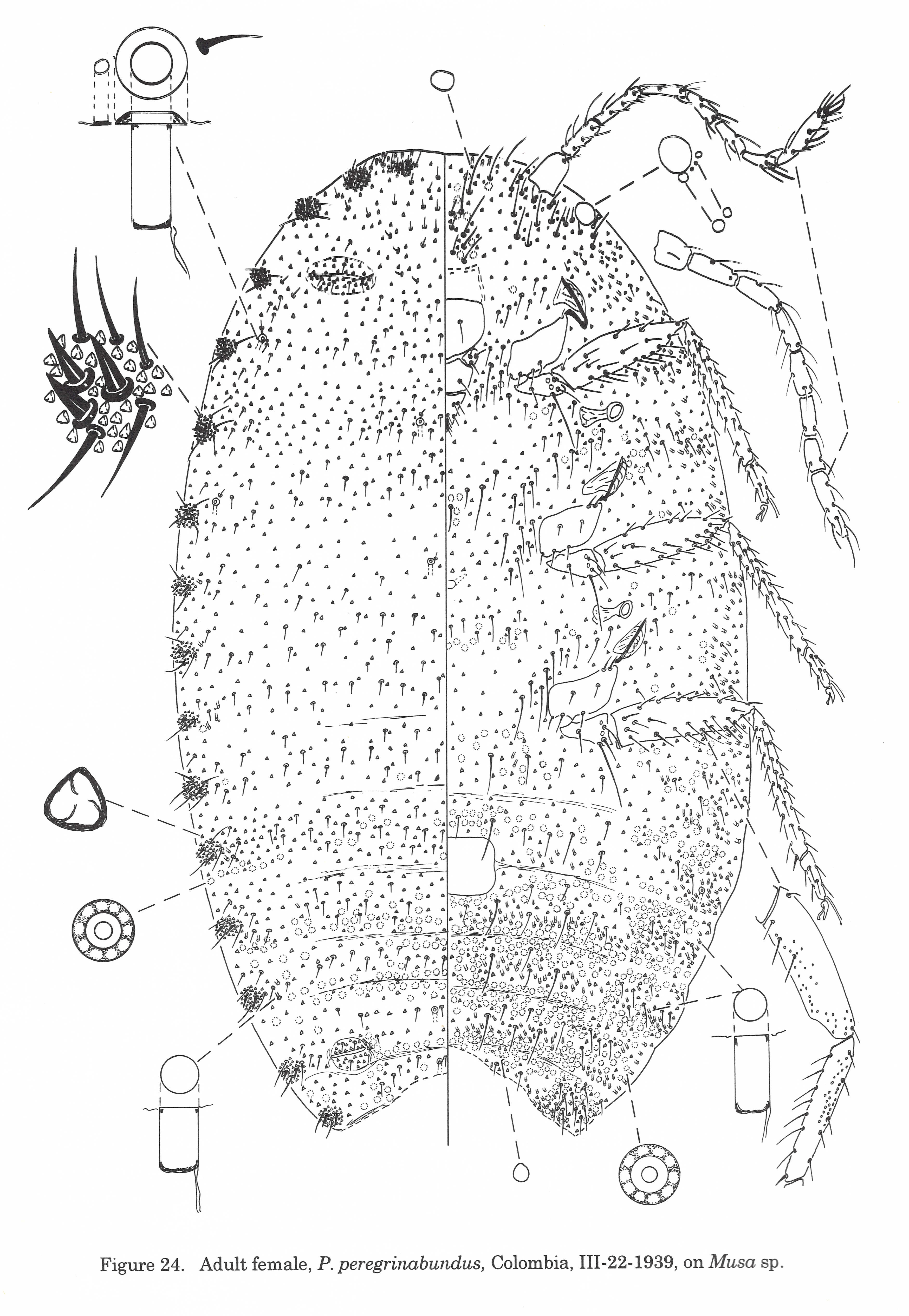Valid Names Results
Pseudococcus peregrinabundus Borchsenius, 1947 (Pseudococcidae: Pseudococcus)Nomenclatural History
- Pseudococcus peregrinabundus Borchsenius 1947b: 2110. Type data: COLOMBIA: intercepted in Russia, Leningrad, on Musa sp.. Holotype, female, Type depository: London: The Natural History Museum, England, UK; St. Petersburg: Zoological Museum, Academy of Science, Russia; accepted valid name
- Pseudococcus columbianus Borchsenius 1947b: 2110. Type data: COLOMBIA: intercepted in Russia, Leningrad, on Musa sp.. Holotype, female, Type depository: St. Petersburg: Zoological Museum, Academy of Science, Russia; junior synonym (discovered by GimpelMi1996, 100).
- Pseudococcus colombianus Borchsenius, 1947; Borchsenius 1948d: 420. misspelling of species epithet
Common Names
- foreign mealybug GimpelMi1996
Ecological Associates
Hosts:
Families: 1 | Genera: 1
- Musaceae
Geographic Distribution
Countries: 1
- Colombia | BenDov1994 Borchs1947b Borchs1948d GimpelMi1996 Kondo2001
Keys
- GranarGo2018: pp.10-14 ( Adult (F) ) [Central & South American Pseudococcus]
- LiLiWa2018: pp.538- ( Adult (F) ) [Species of Pseudococcus]
- PachecKaGe2016a: pp.77 ( Adult (F) ) [Pseudococcus maritimus complex with multilocular disc pores present on dorsum]
- VonEllWa2016: pp.74-75 ( Adult (F) ) [Pseudococcus species present in the New World]
- GimpelMi1996: pp.19 ( Adult (F) ) [World]
- WilliaGr1992: pp.427 ( Adult (F) ) [Central and South America]
- Borchs1948d: pp.418 ( Adult (F) ) [P. comstocki group of species]
- Borchs1947b: pp.2110 ( Adult (F) ) [P. comstocki group of species]
Remarks
- Systematics: Pseudococcus peregrinabundus superficially is similar to P. puertoricensis by having: Numerous multilocular disc pores on the ventral thorax;translucent pores on the hind femur and tibia; several oral collars near cerarius12. Pseudococcus peregrinabundus differs by having: Dorsal multilocular disc pores; 2(1-3) discoidal pores associated with rim of dorsal oral rims; no dorsal oral rim associated with frontal cerarii; longest dorsal body seta 23(22-24)µ long; oral rims absent from submargin of venter between segment II and cerarius 13; antennae 564(503-602)µ long; hind tibia 363(360-366)µ long; 2 dorsal oral rims on abdomen. Pseudococcus puertoricensis has: No dorsal multilocular disc pores; 1(0-3) discoidal pores associated with rim of dorsal oral rims; 1 dorsal oral rim associated with each frontal cerarius; longest dorsal body seta 40(32-52)µ long; 6(5-8) oral rims on submargin of venter between segment II and cerarius 13; antennae 497(473-509)µ long; hind tibia 289(283-302)µ long; 34(30-38) dorsal oral rims on abdomen. (Gimpel & Miller, 1996)
- Structure: With dorsal multilocular disc pores on segments I-VII; multilocular pores abundant on ventral thorax and head; frontal cerarii without associated dorsal oral-rim tubular ducts; translucent pores on hind tibia and femur; 15(14-17) oral-collar tubular ducts on venter mesad of cerarius 12; without oral-rim on dorsal submargin between cerarii 15 and 16.(Gimpel & Miller, 1996)
- General Remarks: Good description and illustration of the adult female given by Borchsenius (1947b, 1948d), Williams & Granara de Willink (1992) and by Gimpel & Miller (1996).
Illustrations
Citations
- BenDov1994: catalog, 384, 407
- Borchs1947b: description, distribution, host, taxonomy, 2110
- Borchs1948d: description, distribution, host, taxonomy, 420
- CaballPaKa2021: distribution, 10
- GimpelMi1996: description, distribution, host, illustration, taxonomy, 100-103
- GranarGo2018: diagnosis, distribution, illustration, key, taxonomy, 10-14, 40
- Kondo2001: distribution, host, taxonomy, 38
- Kondo2019: distribution, 128
- PalmaJBlGu2019: host, 290
- VonEllWa2016: key, 75
- WilliaGr1992: description, distribution, host, illustration, taxonomy, 434-436




